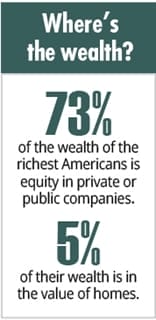The bulk of the wealth of the very rich is in business assets, which benefit the economy
The Democratic hopefuls for president in 2020 are trying to outdo each other with their soak-the-rich tax proposals. Vermont Sen. Bernie Sanders and Massachusetts Sen. Elizabeth Warren propose an annual wealth tax on the richest households, while other candidates push higher taxes on incomes, estates, capital gains and corporations.
Many candidates are parroting Sanders, who says the wealthy are not “paying their fair share of taxes.” But looking at all federal taxes, the average tax rate is 33% for the top 1% of households, 15% for the middle 60% and 2% for the bottom 20%, according to Congressional Budget Office data. Federal taxes are already heavily loaded on high-earners.
Warren, Sanders and others are concerned that wealth is “concentrated.” But the wealth of the wealthy is mainly dispersed across the economy in productive business assets. Looking at the top 0.1% of the richest Americans, 73% of their wealth is equity in private or public companies, while just 5% is the value of their homes.
Looking just at billionaires, only 2% of their wealth is in their homes and personal assets, such as vehicles, jewelry and artwork. The great majority of their wealth is in productive business assets, which generate output for the broader economy.
Nonetheless, many politicians and pundits believe that people with substantial wealth should be targets of heavy taxation. They think that raising taxes on people owning capital would lighten the burden on labor and that taxing wealth would benefit the non-wealthy.
In fact, imposing heavy taxes on wealth would reduce living standards for everyone because it would reduce the overall size of the economy. Under certain assumptions, a basic finding from economic theory is that everybody should want taxes on capital to be low or even zero — including wage-earners who have no capital income.
Lessons from Europe
The Democratic tax hike proposals run counter to international trends.
Since 1981, the average corporate tax rate across major industrial countries has fallen from 47% to 24%, while the average top personal income tax rate has fallen from 66% to 43%. Many countries have cut their capital gains tax, and some have abolished estate and inheritance taxes.
The Democrats’ wealth tax also counters foreign trends — Europe tried wealth taxes and failed.
The number of European countries with wealth taxes fell from 12 in 1990 to just three today. Countries found that the taxes encouraged avoidance, evasion and capital flight. In most countries, wealth taxes raised little revenue and became riddled with exemptions.
The story of Sweden is instructive. It repealed its wealth tax in 2007 as it became clear that the tax was driving entrepreneurs — such as the founder of IKEA, Ingvar Kamprad — out of the country along with their investment capital. The tax also generated domestic avoidance.
Swedish economists Magnus Henrekson and Gunnar Du Rietz found that wealth tax revenues were declining as “people could with impunity evade the tax by taking appropriate measures.” Sweden also abolished its inheritance tax in 2004 because it, too, was driving out wealth.
While some policy-makers portray taxes on the rich as a freebie, international evidence has shown that high tax rates on high-earners and capital make the tax base shrink from domestic avoidance and cross-border mobility. Individuals at the top end have more flexibility in their business and financial affairs than others, so they are more responsive to taxes.
These same competitive pressures affect the states. Of the 25 highest-tax U.S. states, 24 of them had net out-migration in 2016, according to Internal Revenue Service data. Of the 25 lowest-tax states, 17 had net in-migration. The largest out-migration is from high-tax New York, while the largest in-migration is to Florida, which has no income tax or estate tax.
What Wisconsin can do
Wisconsin has suffered from consistent out-migration in recent years. In 2016, 100 people moved out for every 90 who moved in, IRS data show. If you look at those people earning more than $200,000, the ratio is 100 moving out to just 83 moving in.
Some of the movement stems from factors that Wisconsin cannot control — such as the sun and warmth in the Southern states. But policy-makers need to try harder on the factors that they do control, such as tax rates and government efficiency.
The competitive climate won’t get any easier, and states should not expect help from Washington. With federal deficits of $1 trillion a year and rising, federal aid to the states likely will get squeezed as interest costs and entitlement spending rise. The path forward for Wisconsin is to make its government as lean as possible to attract the investment, entrepreneurs and skilled labor that it needs to grow.
Policy-makers in Wisconsin should reject the Warren and Sanders mind-set that wealth is the enemy. Wealth is simply accumulated savings that economies need for investment.
The fortunes of the richest Americans consist mainly of active business assets that generate jobs and income. Increasing taxes on wealth would undermine investment and thus productivity and wage growth. Capital and labor are complements in production and growth, not the opponents that many Democratic politicians seem to believe.
American voters will be making important choices as runaway federal spending threatens to move the government in a higher-tax direction. The states also will be making choices. They can adopt the high-tax, slow-growth model of New York or the low-tax, high-growth model of Florida.
Wisconsin sits in the middle on taxes, but there is no reason the Badger State couldn’t adopt the Sunshine State’s winning approach to taxation.
Chris Edwards is director of tax policy studies at the Cato Institute and editor of www.DownsizingGovernment.org.
Related stories:
► Wealth tax doomed Emil Seidel
► Carl Sandburg recounts his disenchantment





